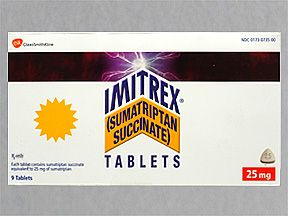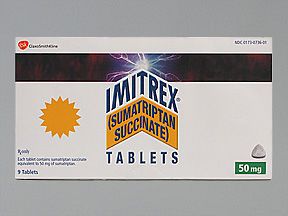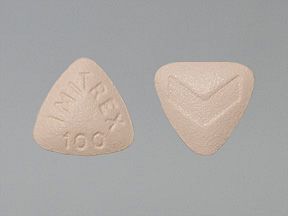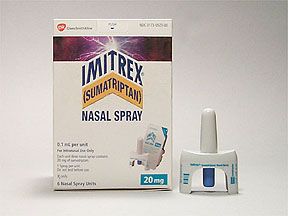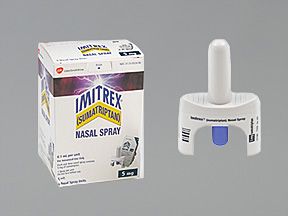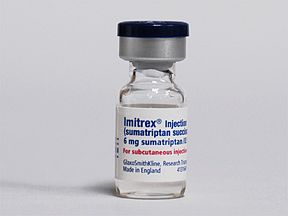If you have migraine, your doctor may suggest Imitrex (sumatriptan) as a treatment option. It’s a prescription medication used to treat migraine (with or without aura) in adults. The injected form of this drug is also used to treat cluster headaches in adults.
In addition to an injection given under your skin, Imitrex is also available as an oral tablet and a nasal spray.
Imitrex belongs to a group of drugs called triptans.
This article describes the dosages of Imitrex, as well as its forms, strengths, and how to take it. To learn more about Imitrex, see this in-depth article.
Note: This article covers Imitrex’s typical dosages, which the drug’s manufacturer provides. But when using Imitrex, always take the dosage that your doctor prescribes.
The following information describes the usual dosages of Imitrex. But be sure to follow the dosing instructions from your doctor.
What are the forms of Imitrex?
Imitrex comes in the following forms:
- an oral tablet (a pill that you swallow)
- a single-dose nasal spray
- a single-dose vial of liquid solution that you inject under your skin using a syringe
- a single-dose prefilled cartridge of liquid solution that you inject under your skin using an Imitrex STATdose pen (a reusable autoinjector device)
What strengths does Imitrex come in?
Imitrex oral tablets are available in three strengths:
- 25 milligrams (mg)
- 50 mg
- 100 mg
Imitrex nasal spray devices contain one dose that you spray into one nostril. This device comes in two strengths:
- 5 mg
- 20 mg
Imitrex vials can be used once only to inject a dose under your skin using a syringe. (Imitrex vials don’t come with syringes or needles.) Each vial contains:
- 6 mg of the drug in 0.5 milliliters (mL) of solution
Imitrex cartridges contain a single dose of liquid solution that you inject under your skin. (You do this by using a reusable autoinjector device called an Imitrex STATdose pen.*) The cartridges come in two strengths:
- 4 mg in 0.5 mL
- 6 mg in 0.5 mL
* Imitrex STATdose pens come with two single-dose cartridges and a carrying case. Your doctor can prescribe refills of the cartridges only, which come in packs of two.
What are the typical dosages of Imitrex?
Typically, your doctor will prescribe a low or moderate starting dose of Imitrex. Then they’ll adjust your dosage over time to reach the right amount for you. Your doctor will ultimately prescribe the smallest dosage that achieves the desired result.
Keep in mind that Imitrex isn’t a drug you take every day. You’ll only take it if you have a migraine or cluster headache episode.
The information below describes dosages that are commonly used or recommended. But be sure to take the dosage your doctor prescribes for you. Your doctor will determine the best dosage to fit your needs.
Dosage for migraine with or without aura
You’ll take one dose of Imitrex after the first sign of a migraine attack. If your migraine symptoms go away completely, you don’t need to take any more doses.
You can take a second dose if:
- your first dose doesn’t fully relieve your migraine symptoms
- your migraine symptoms go away but come back
You should not take a second dose:
- if the first dose of Imitrex doesn’t help your migraine symptoms at all
- unless your doctor recommends you do so
The recommended second dose of Imitrex depends on which form of the drug you’re taking, as follows:
- Imitrex tablets or nasal spray: You can repeat your dose at least 2 hours after the previous dose if your migraine symptoms haven’t gone away.
- Imitrex injections: You can repeat your dose at least 1 hour after the previous dose if your migraine symptoms haven’t gone away.
If your migraine symptoms still aren’t fully relieved after a second dose, you can repeat the steps above. But you should not take more than the maximum dose of this drug. (See the chart below.)
The usual dosage of Imitrex to treat a migraine episode depends on the drug’s form. The chart below summarizes the usual and maximum dose for each form of this drug. But be careful not to take more Imitrex than your doctor prescribes for you.
Your doctor may suggest a dose lower than 6 mg of liquid solution (in case of certain side effects, for example). If so, they will provide guidance on how you should inject Imitrex.
| Form of Imitrex | Possible dose at migraine onset | Maximum dose per 24 hours |
| oral tablet | 25 mg 50 mg 100 mg | 200 mg |
| nasal spray | 5 mg 10 mg* 20 mg | 40 mg |
| injection using cartridges with STATdose autoinjector | 4 mg 6 mg | 12 mg |
| injection using vial and syringe | 1 mg to 6 mg | 12 mg |
* To take a 10-mg dose of Imitrex nasal spray, you’ll use two 5-mg nasal spray devices, one in each nostril.
Dosage for cluster headaches
Only the Imitrex injection is used to treat cluster headaches.
You’ll inject one 6-mg dose of Imitrex under your skin when a cluster headache occurs. If your headache completely goes away, you don’t need to take any more doses.
You can repeat your dose at least 1 hour after the previous dose if:
- your headache hasn’t fully gone away
- your headache goes away but comes back
You should not take a second dose:
- if the first dose of Imitrex doesn’t help your headache at all
- unless your doctor recommends you do so
The maximum dosage of Imitrex injection for cluster headaches is 12 mg in a 24-hour period.
Is Imitrex used long term?
No. Imitrex is a short-term treatment. You’ll only take it when a migraine or cluster headache episode occurs. Imitrex doesn’t prevent migraine or cluster headache episodes. If you and your doctor determine that Imitrex works for you, you’ll only take it when you have an episode.
Imitrex can be used to treat up to four migraine or cluster headache episodes per month. If you have more than four per month, talk with your doctor. They can tell you more about long-term treatment options that may be right for you.
Dosage adjustments
If you have medical conditions that affect your liver, your doctor may prescribe a lower dosage of Imitrex for you.
This section describes how to take or use Imitrex, which comes in several forms.
For information on Imitrex expiration, storage, and disposal, see this article.
How to take your oral dosage
Imitrex tablets are taken by mouth, with or without food.
You should not crush, cut, or chew Imitrex tablets. They should be swallowed whole with water.
If you have trouble swallowing the tablets whole, see this article for tips that may help.
How to take your nasal dosage
Each Imitrex nasal spray device contains one dose that you spray into one nostril.*
You can find detailed instructions for Imitrex nasal spray at the end of the drug’s prescribing information. Instructions also come packaged with each nasal spray device.
If you have questions about using Imitrex nasal spray, talk with your doctor or pharmacist.
* It’s possible that you’ll use two 5-mg nasal spray devices, one in each nostril. But this is only if your doctor prescribes a 10-mg dose of Imitrex nasal spray for you.
How to receive your injection
You’ll inject Imitrex under the skin of your outer thigh or the outer area of your upper arm. Be sure to choose an area with a layer of fat.
Your doctor or pharmacist will teach you how to self-inject using the Imitrex STATdose Pen. The instructions vary depending on whether you’re using an Imitrex STATdose autoinjector or an Imitrex vial and syringe.
You can find detailed instructions for self-injecting at the end of the drug’s prescribing information. These instructions also come packaged with the drug.
Get answers below to common questions about Imitrex’s dosage.
Is there a maximum daily dosage for Imitrex? What about a maximum monthly dosage?
According to the drug’s manufacturer, you should not take more than the maximum daily dose of Imitrex.
The maximum dose per 24-hour period depends on which form of the drug you take and is as follows:
- Imitrex tablets: no more than 200 milligrams (mg)
- Imitrex nasal spray: no more than 40 mg
- Imitrex injection: no more than 12 mg
You can use Imitrex to treat up to four migraine or cluster headache episodes per month. If you have more than four per month, talk with your doctor. They may prescribe a different medication for your condition.
Does the higher strength of Imitrex tablets (25 mg, 50 mg, and 100 mg) mean they might work more effectively than other forms of the drug?
No, the strength of the tablet doesn’t necessarily affect how well the drug works. But some people find that one form of Imitrex works better for them than another. This depends on a person’s symptoms during a migraine episode. And symptoms can vary from one person to the next.
Here are a couple of examples to consider:
- If you have nausea and vomiting during a migraine attack, you may not be able to swallow a tablet or keep it down.
- If you have visual symptoms, such as blurred vision, you may have trouble seeing well enough to give yourself an injection.
Depending on your symptoms, your doctor may have you switch between forms of Imitrex. Talk with your doctor about which forms of Imitrex may be the best fit for you.
Only the injection form of Imitrex is used to treat cluster headaches.
The dosage of Imitrex the doctor prescribes may depend on several factors. These include:
- the type and severity of the condition you’re using Imitrex to treat
- your age
- the form of Imitrex you’re taking
- other conditions you may have (see “Dosage adjustments” under “What is Imitrex’s dosage?”)
Imitrex isn’t a drug that you take every day. You’ll only take it if you have a migraine or cluster headache episode.
It’s best to take Imitrex at the start of a migraine episode. So you should take a supply of Imitrex with you wherever you go. This way, you’ll be prepared to take a dose as soon as symptoms start.
Note that the autoinjector device (called an Imitrex STATdose pen) comes with a carrying case that holds two single-dose cartridges for convenience.
Do not use more Imitrex than your doctor prescribes. Doing so may lead to rebound headaches (also called medication overuse headaches). With rebound headaches, you may experience daily migraine symptoms or have more frequent migraine episodes.
What to do in case you take too much Imitrex
Call your doctor right away if you think you’ve taken too much Imitrex. You can also call 800-222-1222 to reach the American Association of Poison Control Centers or use their online resource. But if you have severe symptoms, call 911 (or your local emergency number) immediately or go to the nearest emergency room.
The sections above describe the typical dosages provided by the drug manufacturer. If your doctor recommends Imitrex for you, they’ll prescribe the dosage and form that’s right for you.
Remember, you should not change your dosage of Imitrex without your doctor’s recommendation. Only use Imitrex exactly as prescribed. Talk with your doctor if you have questions or concerns about your current dosage.
Here are some examples of questions you may want to ask your doctor:
- Does one form of Imitrex work faster than another to relieve migraine or cluster headache episodes?
- Would a higher dose of Imitrex work better for me?
- What should I do if my migraine or cluster headache symptoms aren’t fully relieved after I’ve taken the maximum dosage of Imitrex?
If you have migraine, consider signing up for Healthline’s online newsletter for advice on treating and managing your condition.
Q:
If my doctor prescribes different forms of Imitrex for me, can I switch between them if my migraine symptoms aren’t fully relieved? If so, what’s the usual dosage?
AnonymousA:
Depending on your symptoms, your doctor may recommend that you switch between forms of Imitrex. For example, if your migraine returns after your first Imitrex injection, your doctor may have you take single Imitrex tablets. This could be up to 100 mg per day, with a space of at least 2 hours between tablet doses.
For cluster headaches specifically, only the injection form of Imitrex is used.
Talk with your doctor about which forms of Imitrex may be the best fit for you. And be sure to follow the dosing instructions from your doctor. You should not switch medications or change your dosage without first speaking with your doctor.
Tanya Kertsman, PharmDAnswers represent the opinions of our medical experts. All content is strictly informational and should not be considered medical advice.Disclaimer: Healthline has made every effort to make certain that all information is factually correct, comprehensive, and up to date. However, this article should not be used as a substitute for the knowledge and expertise of a licensed healthcare professional. You should always consult your doctor or another healthcare professional before taking any medication. The drug information contained herein is subject to change and is not intended to cover all possible uses, directions, precautions, warnings, drug interactions, allergic reactions, or adverse effects. The absence of warnings or other information for a given drug does not indicate that the drug or drug combination is safe, effective, or appropriate for all patients or all specific uses.

